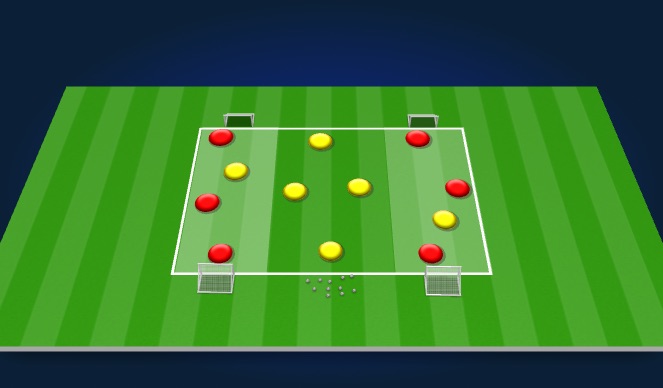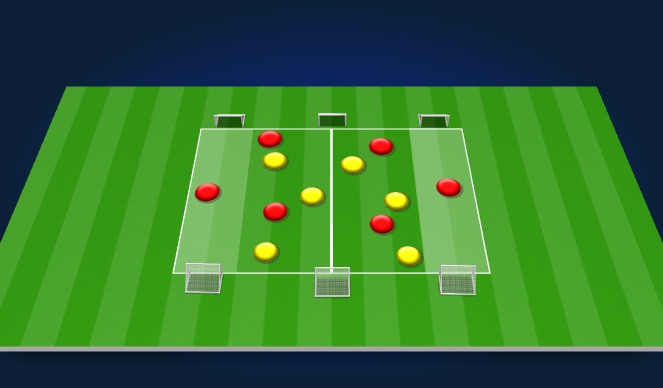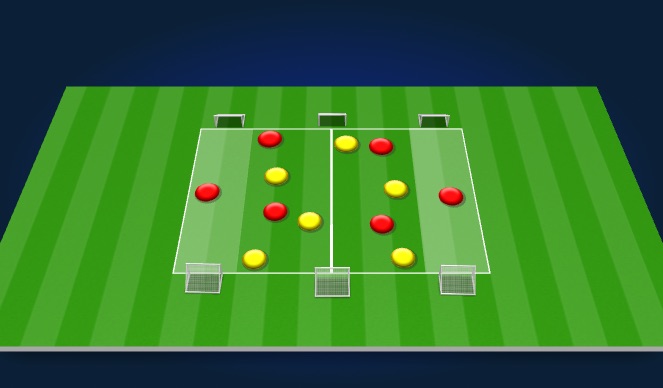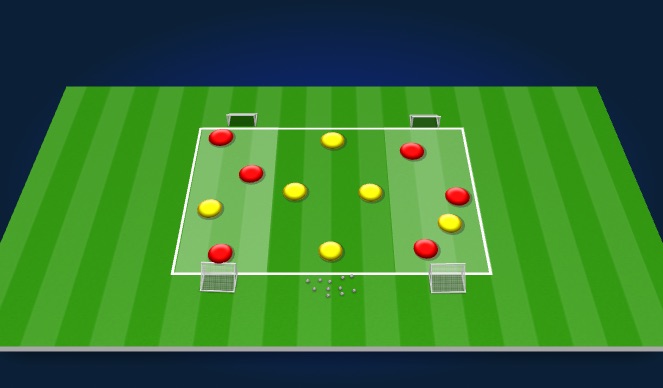Football/Soccer Session (Academy Sessions): Samuel Holmshaw - General practice session 4 - Switching Play

Profile Summary

| Name: | Samuel Holmshaw |
|---|---|
| City: | Shenzhen |
| Country: | China |
| Membership: | Adult Member |
| Sport: | Football/Soccer |
Description
Date: 4/3/25 Player age: U14 Number of Players: 12 Session time: 90 minutes
Topic: Switching play
Primary focus: A general session to help engage players understanding of how to switch play.
Secondary focus: A general session to help engage players understanding of how to stop the switch play.
Main Coaching points
In possession principles: Make the pitch big, maintain width, decision making when to switch, who can switch, export the space, ball speed
Out of possession principles: Force the opposition wide, keep play predictable, pressure on the ball, leave the futhest players
Session objectives:
- All players will be able to recognise how to create a switch of play through making the pitch big and maintaining width.
- Most players will be demonstrate understanding of when to switch the play using appropriate ball speed, considering who is in the best position to switch the play.
- Some players will recognise how to exploit the space to create the option to switch the play.

See the guidance at the top of this page to understand why you are not seeing interactive Football/Soccer images.

OOP 1
Set up: Create a 40 x 15 playing area, that is split into 3 zones, the middle zone being 10m and the two end zones being 15m in width. Split the group up into two teams of six. The team starting IP positions in both end zones (split up into two teams of 3) The team starting OOP can position 4 players in the middle zone, with two players able to start in the wide area.
Timings: 5 x 2 minute blocks, with a 60 second rest in-between.
To Start: the objective of the game is for the IP team to switch the play from one zone. After a successful switch of play, the team can look to score in either goal in their end zone.
If the defensive team win the ball, they may also look to score a goal in the end zone that they won possession from.
Conditions: Each possession team must complete between 3 and 5 passes before switching the play to the other end zone.
The defending team are only allowed 1 players to move into the opponents end zone. They may rotate players, allowing the nearest defender to press the ball.
Upon winning the ball, the defensive team are now allowed to commit unlimited players into the end zone in an attempt to score
Target: Try to prevent the team from switching play initially, upon regaining the ball attempt to score a goal in the end zone possession was won from.
Challenges: Challenge the team to stopping the switch and regaining the ball or forcing the ball out of play.
Progressions
Remove the passing condition for the attacking team, now attackers can switch the play immediately to score.
Add an IP player on the sideline to allow playing around to switch and allow an IP player enter the middle area to link play and switch.
Regressions:
If not enough success in stopping the switch of play, consider allowing a second defender to enter the end zone to press.
Add the condition that the ball can only be played on the floor meaning the team IP is now not allowed to switch by playing over.
Coaching points:
After block 1: The nearest player should press the ball immediately. Acceleration, Deceleration, Body Shape, Distance from attacker (dictate where), Delay or win ball (how do we decide? {oppositions first touch, body shape, movements, situations around us}). Don’t stab at the ball, use the jockey technique.
Individual + 1: When the player makers the decision to press, teammate drops back into the shape.
Pressing pattern, when pressing in wide areas, attempt to force the player outside to limit passing options to switch, forcing inside may allow the player to find the spare player that engages a switch. Teammates must block passing lanes to prevent play across.
After block 2: Force the opposition to play wide, after nearest player presses, engage in defensive lines to block central passing lanes and shift across left or right to follow the ball.
Individual + 1: When the player makes the decision to press, a teammate must shift across to cover the vacated space.
After block 3: Keep the oppositions play predictable by dictating their play, fast initial pressure and blocking the passing should always force the play wide
After block 4: Leave the furthest players - follow the play, shifting across left or right, if the play is transferred to the furthest player, nearest player fast pressure, remaining defenders engage in defensive lines and shift across.
Individual + 1 : recognise teammate movement, when teammate shifts across or presses, quickly close the passing lane

See the guidance at the top of this page to understand why you are not seeing interactive Football/Soccer images.

IP 2
Set up:
Create a 35 x 50m area. Split the area into 4 zones, with two wide zones being 10m in length and two central zones being 15m in length. Add 3 mini goals as shown in the diagram, two in each wide zone and one in-between both central zones. Split the group up into two teams of 6.
Timings:
5 x 2 minute blocks, with a 60 second rest in-between.
To Start:
A 6 vs 6 small sided game. The aim of the activity is to switch play from one end zone to another to score.Conditions: The team in possession can spread across all 4 channels. The team out of possession can move in central areas, but may only move into the wide area once the play has entered the wide area.
This will assist learning on creating and maintaining width, switching quickly and progressing quickly to exploit space.
Targets: scoring in a central goal from a build up of a switch of play from the other half of the pitch is given 2 points. If no switch of play, only 1 point is given.
A switch of play into the other wide area to score is awarded 1 point.
Challenges: Can the team in possession spread out and use the full width of a pitch, having a player in each wide area to create a passing lane to provide an option to switch.
How many goals can we score directly from switching the play?
Progressions: Limit the IP team to 2/3 touches on the ballAdd the restriction that the IP team now need to make 3 passes in the build up before a switch of play can take place.
Regressions: allow more touches on the ball for the IP team.
Coaching points:
After block 1: Make the pitch big and use the full width of the field. Keep possession on one side of the pitch to attract pressure from the opposition.Tempo of play, moving the ball quickly to create opportunities to switch.
Individual + 1: teammate needs to stay wide and isolated in the opposite wide area whilst the play is on one side of the pitch to create the passing option to then engage in the switch.
After block 2: Decision making when to switch - switching the ball quickly when the opposition is drawn into one side. Players scan prior to receiving the ball, scanning ahead of time for opportunities to switch over. Passing techniques for long diagonal passes or playing to anchor (Lofted & Driven passes).
After block 3: Who can switch - wide player makes use of long diagonal passes to switch the play from one wide area to the other, or look to play the ball into the central player who acts an an anchor to switch the play.
Receiving mechanics, open body shape, back foot receive on half-turn to progress and switch the play quickly. Receive on the front foot if under pressure and play quickly. Passing techniques for long diagonal pass or playing to anchor (Lofted & Driven passes).
Individual + 1: in addition to a teammate staying wide and isolated, a teammate needs to create depth to ensure a passing lane is open for the option to play centrally and switch wide.
After block 4: Exploit the space, utilising the width to create the option to switch and score quickly in wide goals.
Individual + 1: Isolated player uses movement off the ball to move wide, evade defender and create spaceRepeat coaching points during concurrent feedback when necessary, may use walkthrough feedback when required.
Consider progressing or regressing practice in-between blocks.

See the guidance at the top of this page to understand why you are not seeing interactive Football/Soccer images.

OOP 2
Set up:
Create a 35 x 50m area. Split the area into 4 zones, with two wide zones being 10m in length and two central zones being 15m in length. Add 3 mini goals as shown in the diagram, two in each wide zone and one in-between both central zones. Split the group up into two teams of 6.
Timings:
5 x 2 minute blocks, with a 60 second rest in-between.
To Start:
A 6 vs 6 small sided game. The aim of the activity is to switch play from one end zone to another to score.
Conditions: The team in possession can spread across all 4 channels. The team out of possession can move in central areas, but may only move into the wide area once the play has entered the wide area.
This will assist learning on leaving the furthest players, and forcing the play wide to then get across and press quickly to regain the ball.
Targets: The target for the defensive team is to win possession, then build or switch the play quickly to counter attack and score.
Challenges: Can the defensive team get compact into defensive lines, attempt to dictate the opposition play wide and then press quickly to regain the ball.
Challenge the defensive team to how many times they can prevent the switch of play and how many regains they can make to score.
Progressions: If the defenders need a progression, add the challenge that once the play has been switched into the wide area, the defenders cannot enter, forcing defenders to stop the switch of play before it is transferred wide.
Regressions: If too difficult for defenders, allow one defender to go into each wide zone, only 1 defender can enter the wide zone at any one time.
Coaching points:
After block 1: The nearest player should press the ball immediately. Acceleration, Deceleration, Body Shape, Distance from attacker (dictate where), Delay or win ball (how do we decide? {oppositions first touch, body shape, movements, situations around us}). Don’t stab at the ball, use the jockey technique.
Individual + 1: When the player makers the decision to press, previous pressing teammate drops back into the shape.
Pressing pattern, in wide areas attempt to force the player outside to limit passing options to switch, forcing inside may allow the player to find the spare player that engages a switch. Teammates must block passing lanes to prevent play across. When pressing centrally, attempt to force the player wide though blocking the central passing lanes.
After block 2: Force the opposition to play wide (or around), after nearest player presses, engage in defensive lines to block central passing lanes and shift across left or right to follow the ball.
Individual + 1: When the player makers the decision to press, a teammate must shift across to cover the vacated space.
After block 3: Keep the oppositions play predictable by dictating their play, fast initial pressure and blocking the passing should either keep the play in one wide area to force a mistake, or force the play wide.
After block 4: Leave the furthest players - follow the play, shifting across left or right, if the play is transferred to the furthest player, nearest player fast pressure on the ball, especially when transferred into wide areas, remaining defenders engage in defensive lines and shift across.
Repeat coaching points during concurrent feedback when necessary, may use walkthrough feedback when required.
Consider progressing or regressing practice in-between blocks.









 Play animation
Play animation Play step-by-step
Play step-by-step Repeat (toggle)
Repeat (toggle) Full Screen
Full Screen Pause
Pause Stop
Stop
IP 1
Set up: Create a 40 x 15 playing area, that is split into 3 zones, the middle zone being 10m and the two end zones being 15m in width. Split the group up into two teams of six. The team starting IP positions in both end zones (split up into two teams of 3) The team starting OOP can position 4 players in the middle zone, with two players able to start in the wide area.
Timings: 5 x 2 minute blocks, with a 60 second rest in-between.
To Start: the objective of the game is for the IP team to switch the play from one zone. After a successful switch of play, the team can look to score in either goal in their end zone.
If the defensive team win the ball, they may also look to score a goal in the end zone that they won possession from.
Conditions: Each possession team must complete between 3 and 5 passes before switching the play to the other end zone.
The defending team are only allowed 1 players to move into the opponents end zone. They may rotate players, allowing the nearest defender to press the ball. The other defenders must stay in the central zone.
Upon winning the ball, the defensive team are now allowed to commit unlimited players into the end zone in an attempt to score.
Target: The target is for the team in possession to switch play from one end zone to the other to score a goal.
Challenges: Challenge players on how to draw the opposition players in to create space in behind. Decision making to switch the play quickly.
Progressions: Limit to 2/3 touches on the ball
Allow a second defender in the end zone to press the ball
Regressions: allow the IP team more touches on the ball
Allow a player from each IP team to enter the central area, allowing teams switch play through a link player in the central area.
Coaching points:
After block 1: Make the pitch big and use the full width of the field. Keep possession on one side of the pitch to attract pressure from the opposition. Tempo of play - move the ball quickly to create opportunities to switch.
Individual + 1: teammate needs to stay wide and isolated whilst the play is on one side of the end zone, whilst this creates the passing option to then engage in the switch.
After block 2: Decision making when to switch - switching quickly when the opposition is drawn into one side. Players scanning prior to receiving the ball, scanning ahead of time for opportunities to switch over. Passing techniques for long diagonal pass or playing to anchor (Lofted & Driven passes).
Who can switch - wide player makes use of long diagonal passes to switch the play, through the line or over the line. Receive on the front foot if under pressure and play quickly.
(after regression) - Play into a player into the central area to act as an anchor or to play around the line. Open body shape when receiving the ball, back foot receive/ receiving on half turn to play if no pressure.
Individual + 1: a teammate needs to add depth in addition to width to ensure a passing lane open for option to play centrally and switch
After block 3: Exploit the space, utilising the width to create time and space.
Ball speed: Weight of the pass important for switching using diagonal passes, suitable weight to reach isolated winger.
Individual + 1: Isolated player uses movement off the ball to move wide, evade defender and create space for passing option
Repeat coaching points during concurrent feedback when necessary, may use walkthrough feedback when required.Consider progressing or regressing practice in-between blocks.